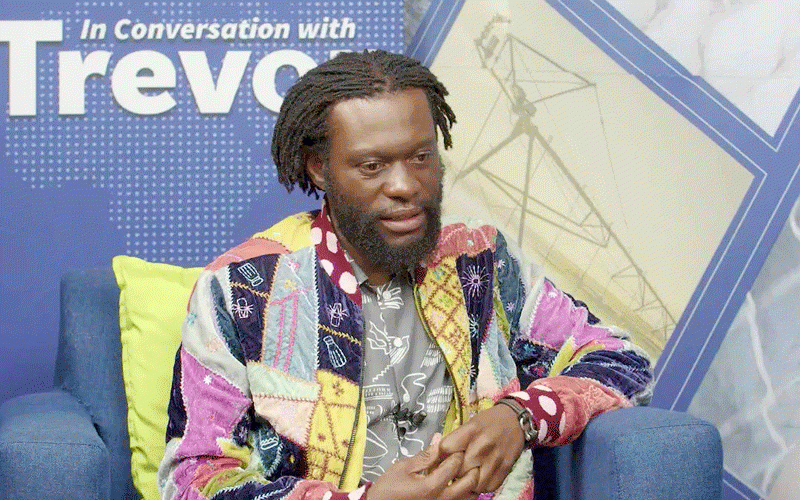
United States-based contemporary visual artist Moffat Takadiwa says he chose to create art using garbage to go around the shortage of materials at the height of Zimbabwe’s economic problems.
Takadiwa (MT) told Alpha Media Holdings chairman Trevor Ncube (TN) on the platform In Conversation with Trevor that when he was studying art around 2008 it was difficult for “any student to find a traditional art material”.
He said as students they ended up looking for alternative material to do assignments and that drew him to making art from refuse.
Below are the excerpts from the interview.
TN: Moffat Takadiwa, welcome to In Conversation With Trevor.
MT: Thank you. I am happy to be on this platform.
TN: You know Moffat, I have had presidents, people who aspired to be presidents sitting on that chair, but your story just is something else.
- Education crisis mirrors national problem
- USD fees: Govt policy failure hurting parents
- Zim has 2nd highest rising food prices: WB
- US raises red flag on abuse of journos in Zim
Keep Reading
I am even staggering to get the right words, you are such an inspiration, your story is authentic, it is original.
I am excited to share your story with the viewers out there.
For the viewers to understand who you are I must ask you this question:
What do you do? What does your work involve? Let us start it there.
MT: Thank you very much for that introduction.
My work involves everyday refuse, so I am more of a garbage collector.
I work with everyday refuse to reflect on everyday lives of mostly Zimbabwean people, and tell a Zimbabwean story through these objects.
TN: Yeah. Now, what made you start doing this work? It is such an unusual work, to collect what people throw away and use to create art. Talk to us about that. What made you do it?
MT: You know at first when I was still studying art; I studied at the Harare Polytechnic around the year 2006/2007 up to 2008.
You realise that was more like a very tough time for the country and it was difficult for any student to find traditional art material.
So somehow, we ended up looking for something else, which we could use to produce work and submit assignments.
So that was the first setting which pushed me into these materials.
TN: Wow. So instead of, because I think the way some people would have reacted is that there is no material.
MT: Yes.
TN: So I am going to do something else, there is no material I cannot do the work.
But you say to yourself there is no material but there is garbage, people are throwing away stuff.
I am going to use that stuff. I must still ask, where did that come from? Where did that idea come from?
MT: I would say later on in my practice, you know when you are reflecting back, I also realised you know when I grew up in a small town in Karoi, in the farming areas.
A small town called Tengo actually.
My father worked in a supermarket, and I grew up maybe surrounded by these objects, you know consumables.
So I think maybe the love for objects goes way back to when I was young.
My father actually worked for more than 35 years in a supermarket.
So, my whole entire young and teenage life was surrounded by these objects.
So there was maybe that subconscious love for and appreciation for these objects and their maybe aesthetic look, design, colour and so on. So there are many things maybe which come into play when I think about what I use.
TN: You know the one other thing that really makes me, and has made me fall in love with your work ..., I have been kicking myself because until we started wanting to talk to you I did not know that you existed.
But when I started looking at your work my mind was absolutely blown away by what you are doing.
So you have decided essentially, that you find opportunity in a crisis and I think for me that is a big lesson for us out there, because the tendency is in a crisis we fold, we wilt, we give up.
But 2008 we were in a crisis and there was no material to work with, and you become this creative?
Talk to me about that.
MT: I think that is the main... I will say crux around my work; is to give life to these materials, which are lifeless.
So maybe it talks into that.
How I think art in general maybe thrives through difficult times as you see a lot of very successful artists, normally they come from that kind of situation.
TN: I think the beauty about you is that you are authentic.
You are not copying anybody, you are authentic.
You are doing something that not many people do, and I just find that mind-blowing, and it takes somebody who appreciates art to look at your pieces and say wow, this piece is about US$200 000.
What has been the reaction of the public, the Zimbabwean public to your work, positive and negative?
MT: To be honest with you I think I was not on the radar in this country.
I would say after I finished studying at Harare Polytechnic I kind of founded a gallery.
So with the other galleries it became quite problematic to them and they did not want me to show my work.
So for some time I was not really shown in the country, and with this gallery which I found we had to find a market elsewhere.
So it pushed me to really read, research, and understand how the art market works, how the global art world works.
I managed to get sort of international attention and recognition before being noticed even at home.
I will say, the show which I have which is happening now in Zimbabwe is like my first show in a decade, in 10 years, this is my first time showing a body of work here in Zimbabwe.
The work was well received, I broke a lot of records for the gallery, for the National Gallery of Zimbabwe since it was opened...
TN: The work that is currently showing?
MT: Yes.
TN: Okay. Which we are going to take a look around yeah?
MT: Yes. In the early 1950’s when the National Gallery was opened, they never reached records as I have done.
TN: Wow. What kind of records are you talking about, attendance? Just break down the record for us.
MT: From the launch of the show the gallery received almost more than a thousand people who were packed in that gallery.
People could not fit in the gallery.
Along the whole of Julius Nyerere Street people could not find parking, just to come and see my show.
You know for a Zimbabwean audience, people sometimes just hesitate to just walk into that gallery.
But for my show we had people who have never stepped a foot into that gallery.
During the duration of the show I was told they would have like six or seven buses loaded with students, schools coming to just see the show every day.
Just in two weeks when the show was opened, the curator Fadzai Muchemwa, she told me like we have already received more people than the entire last year.
TN: Wow!
MT: So this is very important for me when I am received at home, because like any other artist, we put our people at the centre of our practice, we communicate mostly to our people.
TN: You put people, your people at the centre of the practice?
MT: Yes.
TN: But until you were recognised outside, your people did not recognise you?
MT: Yes.
TN: You are saying your work was not being shown locally? Why were the other galleries not interested in showing your work?
MT: I would say maybe it is like that in most industries that have doorkeepers.
Sometimes people can easily make enemies with their competitors, I would say that, because I founded a gallery and most people were not happy...
TN: What is the name of your gallery by the way?
MT: The gallery which I co-founded is still running, it is First Floor Gallery.
It is still running, and is still doing very well. But I left the gallery, I think after four years of running it, and it is being run by other people and it is doing very well. Yes.
TN: Tell me your reaction to the way the Zimbabwean public ignored your work?
And now they are coming around to recognise it. Tell me what kind of emotion that elicits from you.
MT: During that time, I was working with other peers, fellow artists, so working as a collective, and I remember we used to tell each other that guys we just need to make the fire, someone will see the smoke.
That is exactly what we were telling each other. We were saying this is just a small maybe fish pond, we really want to swim in the ocean.
So we started to really read about the global art market and understand it.
And you know by that you begin to understand that there is a bigger picture to this.
You also understand that a lot of people they can strive but they are not even in the mainstream market.
They are in the parallel market.
So we really want it to be in the art market with my friends and somehow I think we found a way and we ended up being in the market.
But other people whom I was working with I would say I realised that I was training actually a generation of artists, like more than 10 to 15 artists whom I was working with, inspiring and we ended up all being successful.
TN: Wow. My heart is going boom boom as you are talking, I mean I am just excited.
I like what you say, let us make the fire, they will notice.
What would you say to artists, musicians, people who are hustling and struggling that have gone through what you have gone through?
What lessons do you think your experience offers?
What message do you have for people that have been in the space that you have been?
It cannot be an easy space to be in. What message do you have for them?
MT: I will say it is not easy. And sometimes it is the light at the end of the tunnel. Yeah. So they need to just follow their own path. Yes.
TN: Keep focused. Let us go on now. I like the phrase that is used.
You work with found material? I think that is a beautiful thing, that is a beautiful phrase, that is a beautiful way of putting it.
Let us go now to that found material. If you could just go through it, what material do you work with?
MT: I look at everyday refuse. These are from what we use as consumer objects, and what we throw in the bin.
I have a small team outside the studio, people go around garbage sites.
Most of them used to be vagabonds, for lack of a better word.
I ended up through many years recruiting some of these people to build trust and work with me to mobilise and look for certain items.
Then they bring these items to my studio. In my studio we prepare, we clean these materials...
TN: Let us name these materials? What are they? These are. Just name them?
MT: From your everyday objects I mean like a toothbrush for instance.
Your electronic waste from computer keys, to materials like bottle caps.
TN: Bottles?
MT: Yes.
TN: Alcohol bottles, soft drink bottles?
MT: Yes.
TN: All those kinds of things?
MT: Yes.
TN: Wow.
MT: The list is actually endless, and in my recent show I have expanded also my definition of everyday materials into things like tables, even what we consume can be like maybe vegetables.
In my recent show you will find rugare, covo vegetables planted in the gallery.
So I will see that just as everyday materials or consumables.










